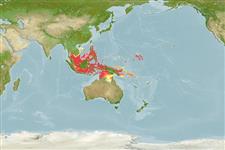Environment: milieu / climate zone / depth range / distribution range
экология
морской; солоноватоводный демерсальный; пределы глубины 2 - 30 m (Ref. 126081). Tropical
Indo-Pacific: tropical to subtropical waters; southeastern Indian and western Pacific oceans (recorded from Japan, East China Sea, Taiwan, Philippines, Vietnam, Singapore, Indonesia, Papua New Guinea, Samoa, and Australia),
Size / Вес / Возраст
Maturity: Lm ? range ? - ? cm
Max length : 38.0 cm TL самец/пол неопределен; (Ref. 4900)
Краткое описание
определительные ключи | морфология | морфометрия
членистые (мягкие) лучи спинного плавника (общее число) : 64 - 76; членистые (мягкие) лучи анального плавника: 51 - 62; позвонки: 41 - 44. This species is distinguished by the following set of characters: D 64-76 (mode 71); A 51-62; pored lateral line scales on straight portion 93-126 (118); vertebrae 41-44 (43); pectoral-fin rays on ocular side 4-7 (6) and on blind side 4-7 (5); pelvic-fin rays on ocular side 4-6 (5) and blind side 4-5 (4); caudal-fin rays 13-15 (14); body slightly elongate, its depth 40.0-51.0 (mean 45.5)% SL; head length 16.1-23.9 (18.6)% SL; pectoral fin on ocular side longer than that on blind side, 5.3-7.6 (6.6)% SL vs. 4.0-6.0 (4.8)% SL; pelvic fin on ocular side longer than that on blind side, 4.9–7.4 (6.0)% SL vs. 4.3–7.5 (5.8)% SL; body depth below lateral line 21.7-27.1 (23.4)% SL; lips without labial papillae; eyes separated by scaled interorbital space; cycloid or weakly ctenoid scales on blind side. Colouration: body on ocular side uniformly brown or grey with dark vermiculation, some small white blotches along dorsal- and anal-fin bases, or no remarkable pattern (Ref. 126081).
Inhabits sheltered bays and lagoons on pale sandy substrates near reefs (Ref. 48637). Collected froom from shallow marine and estuarine waters in less than 5 m; but there are underwater photographs of individuals on shallow sandy bottoms between 2–30 m depth (Ref. 126081).
Life cycle and mating behavior
половая зрелость | размножение | нерест | икра | Fecundity | личинки
Okamoto, J.O. and H. Motomura, 2021. Redescription of Brachirus aspilos (Bleeker 1852), a senior synonym of four nominal species, with a note on the distribution of Dagetichthys marginatus (Boulenger 1900) (Pleuronectiformes: Soleidae). Zootaxa 4908(3):354-368. (Ref. 126081)
Статус Красного Списка МСОП (Ref. 130435: Version 2024-1)
Угроза для людей
Harmless
Использование человеком
дополнительная информация
инструменты
Специальные отчеты
Скачать в формате XML
ресурсы в Интернет
Estimates based on models
Preferred temperature (Ref.
123201): 21.1 - 28.4, mean 27.1 °C (based on 499 cells).
Phylogenetic diversity index (Ref.
82804): PD
50 = 0.5000 [Uniqueness, from 0.5 = low to 2.0 = high].
Bayesian length-weight: a=0.00977 (0.00466 - 0.02049), b=3.07 (2.90 - 3.24), in cm total length, based on LWR estimates for this (Sub)family-body shape (Ref.
93245).
Trophic level (Ref.
69278): 3.7 ±0.4 se; based on size and trophs of closest relatives
устойчивость к внешним воздействиям (Ref.
120179): средний (среднего размера), минимальное время удвоения популяции 1.4-4.4 года (Preliminary K or Fecundity.).
Fishing Vulnerability (Ref.
59153): Low to moderate vulnerability (28 of 100).
